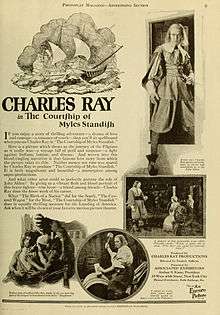The Courtship of Miles Standish (1923 film)
| The Courtship of Miles Standish | |
|---|---|
 Contemporary magazine advertisement | |
| Directed by | Frederick Arthur Sullivan |
| Written by | Al Ray (scenario) |
| Based on |
The Courtship of Miles Standish by Henry Wadsworth Longfellow |
| Starring |
Charles Ray Enid Bennett E. Alyn Warren |
| Cinematography | George Rizard |
Production company |
Charles Ray Producing Inc. |
| Distributed by | Associated Exhibitors, Inc. |
Release dates |
|
Running time | 90 minutes |
| Country | United States |
| Language |
Silent English intertitles |
The Courtship of Miles Standish is a 1923 American silent epic historical romantic drama film produced by and starring Charles Ray, Enid Bennett, and E. Alyn Warren.[1] Directed by Frederick Arthur Sullivan, the film is based on the famous Henry Wadsworth Longfellow 1858 poem The Courtship of Miles Standish.[2] No known prints of the film exist and it is now presumed lost.[3]
Background and production
Actor Charles Ray had risen to fame in the mid to late 1910s playing young wholesome farm boys in silent comedy films directed by Thomas H. Ince for Paramount Pictures.[4] At one point, he was earning $11,000 a week.[5] He left Paramount in 1920 after Adolph Zukor reportedly refused to give him a substantial raise, and formed his own production company, Charles Ray Productions.[4] The company produced several fairly successful comedy films from 1920 to 1922.
Ray then decided to produce a film that was a departure from his earlier work and would feature him in the role of a romantic leading man.[4][6] Against the advice of producers and friends, Ray chose to make a historical epic costume drama based on Henry Wadsworth Longfellow's 1858 narrative poem The Courtship of Miles Standish.[7]
After failing secure financial backing from a major studio, Ray put up $500,000 of his own money to fund the project.[8]
The film was shot in part at the Charles Ray Studio located on Sunset Boulevard (now known as the KCET Studios) in Los Angeles which Ray purchased around 1922.[9] On one of the studio's sound stages, Ray had a 180-ton rocking replica of the Mayflower built that cost a reported $65,000 (approximately $904,000 today).[10][11] Other sequences were shot in Lake Arrowhead, California where Ray had three full sized log cabins built for exterior shots.[12] By the end of filming, Ray had spent over $1,000,000 of his own money and the film's budget reportedly rose to $3,000,000.[13]
Cast
- Charles Ray as John Alden
- Enid Bennett as Priscilla Mullens
- E. Alyn Warren as Myles Standish
- Joseph Dowling as Elder Brewster
- Sam De Grasse as John Carver
- Norval MacGregor as William Bradford
- Thomas Holding as Edward Winslow
- Frank Farrington as Isaac Allerton
- Billy Sullivan as John Howland
- Cammilla Johnson as Little girl
- Adamae Vaughn unidentified role
Reception
Upon its release, The Courtship of Miles Standish received some favorable reviews from critics but was not well received by audiences.[2][14][15] Frederick James Smith described the film was "merely dull." "The acting is not much," he wrote. "Ray seems oppressed by the historical significance of John, and he allots himself entirely too much film. Enid Bennett makes Priscilla a simpering and almost insufferable ingenue."[16] The film was a box office failure and lost $1,000,000.[17] Due to the film's failure, Ray's production company went bankrupt and he was forced to declare personal bankruptcy.[9]
Ray's career never rebounded from the failure of The Courtship of Miles Standish. He continued acting but appeared in smaller budget productions in supporting roles. During the sound era, Ray appeared it bit parts and filed for bankruptcy a second time in 1934.[4] He died of a mouth and throat infection in November 1943.[5]
References
- ↑ White Munden, Kenneth (1997). The American Film Institute Catalog of Motion Pictures Produced in the United States: Feature Films, 1921–1930. University of California Press. p. 149. ISBN 0-520-20969-9.
- 1 2 Snow, Stephen Eddy (2008). Performing the Pilgrims: A Study of Ethnohistorical Role-Playing at Plimoth Plantation. Kirshenblatt-Gimblett, Barbara. Univ. Press of Mississippi. p. 20. ISBN 1-60473-181-8.
- ↑ The Courtship of Miles Standish at SilentEra
- 1 2 3 4 Slide, Anthony (2002). Silent Players: A Biographical and Autobiographical Study of 100 Silent Film Actors and Actresses. University Press of Kentucky. pp. 325–326. ISBN 0-8131-2249-X.
- 1 2 "Hollywood Star Walk: Charles Ray". latimes.com. Retrieved May 31, 2013.
- ↑ Motion Picture, Volume 45. Macfadden-Bartell. 1933. p. 86.
- ↑ Marion, Frances (1972). Off With Their Heads!: A Serio-Comic Tale Of Hollywood. Macmillan. p. 107.
- ↑ Beauchamp, Cari (1998). Without Lying Down: Frances Marion and the Powerful Women of Early Hollywood. University of California Press. p. 159. ISBN 0-520-21492-7.
- 1 2 Alleman, Richard (2013). Hollywood: The Movie Lover's Guide: The Ultimate Insider Tour of Movie L.A. Random House Digital, Inc. p. 169. ISBN 0-8041-3777-3.
- ↑ Rasmussen, Cecilia (August 1, 1999). "Film Pioneer Griffith Rode History to Fame". latimes.com. Retrieved May 30, 2013.
- ↑ Brownlow, Kevin (1979). Hollywood, the pioneers. Knopf. p. 247. ISBN 0-394-50851-3.
- ↑ Cozad, W. Lee (2002). Those Magnificent Mountain Movies: The Golden Years 1911–1939. p. 95. ISBN 0-9723372-1-0.
- ↑ Transatlantic, Issues 1-16. Writers' War Board. 1943. p. 37.
- ↑ Hart, James David (1961). The Popular Book: A History of America's Literary Taste. University of California Press. p. 232.
- ↑ Nash,, Jay Robert; Connelly, Robert; Ross, Stanley Ralph (1988). Motion Picture Guide Silent Film 1910–1936. 10. Cinebooks. p. 53. ISBN 0-933997-10-8.
- ↑ Smith, Frederick James (April 1924). "New Screenplays in Review". Screenland. New York: Screenland, Inc. Retrieved January 31, 2016.
- ↑ Karney, Robyn (1984). The Movie Stars Story. Crescent Books. p. 34. ISBN 0-517-43736-8.